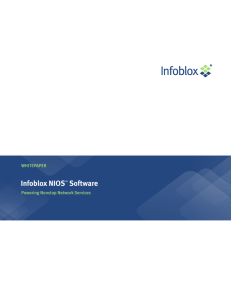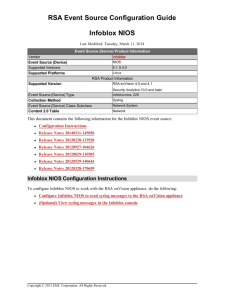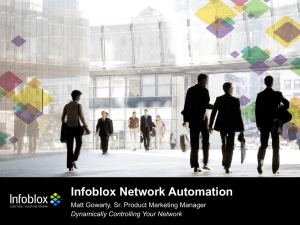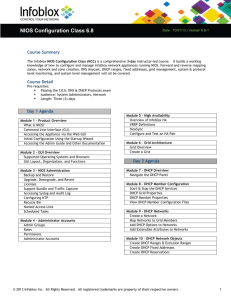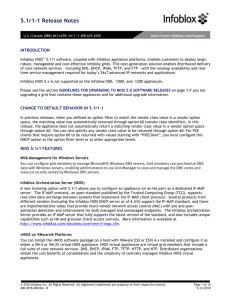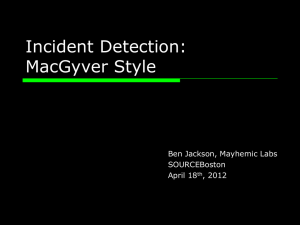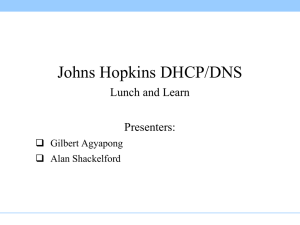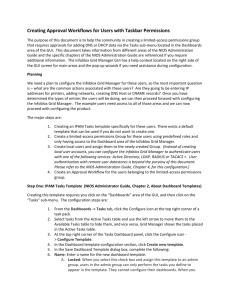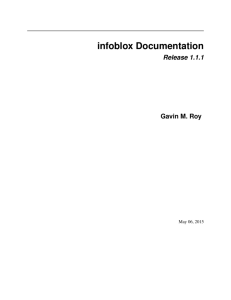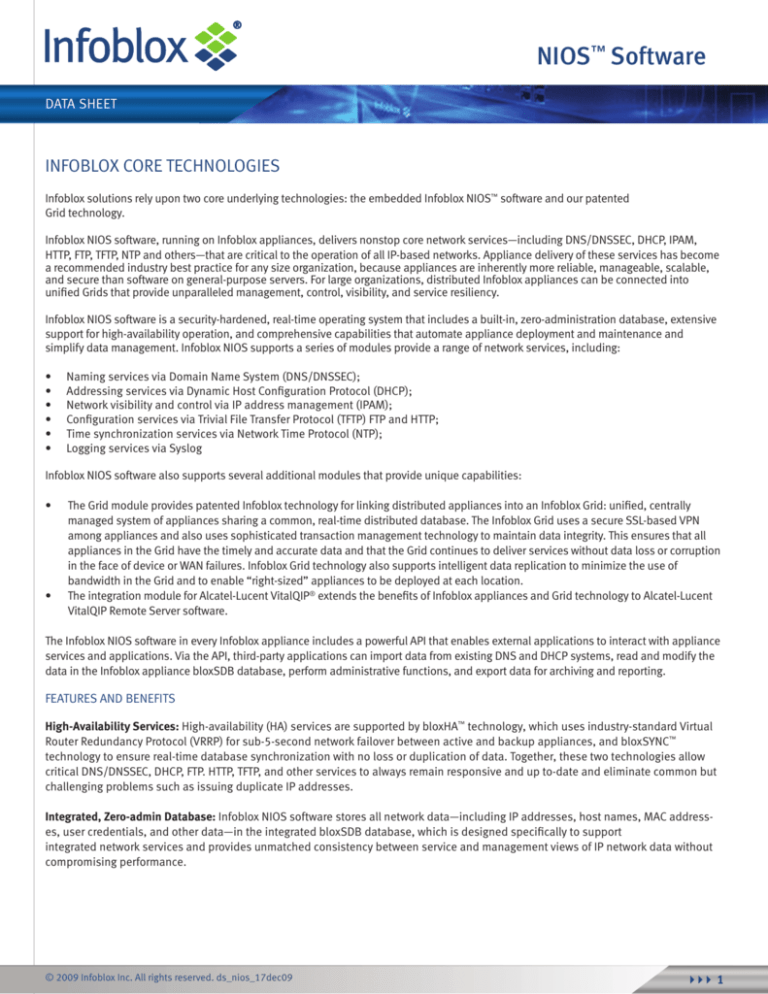
NIOS™ Software
DATA SHEET
INFOBLOX CORE TECHNOLOGIES
Infoblox solutions rely upon two core underlying technologies: the embedded Infoblox NIOS™ software and our patented
Grid technology.
Infoblox NIOS software, running on Infoblox appliances, delivers nonstop core network services—including DNS/DNSSEC, DHCP, IPAM,
HTTP, FTP, TFTP, NTP and others—that are critical to the operation of all IP-based networks. Appliance delivery of these services has become
a recommended industry best practice for any size organization, because appliances are inherently more reliable, manageable, scalable,
and secure than software on general-purpose servers. For large organizations, distributed Infoblox appliances can be connected into
unified Grids that provide unparalleled management, control, visibility, and service resiliency.
Infoblox NIOS software is a security-hardened, real-time operating system that includes a built-in, zero-administration database, extensive
support for high-availability operation, and comprehensive capabilities that automate appliance deployment and maintenance and
simplify data management. Infoblox NIOS supports a series of modules provide a range of network services, including:
•
•
•
•
•
•
Naming services via Domain Name System (DNS/DNSSEC);
Addressing services via Dynamic Host Configuration Protocol (DHCP);
Network visibility and control via IP address management (IPAM);
Configuration services via Trivial File Transfer Protocol (TFTP) FTP and HTTP;
Time synchronization services via Network Time Protocol (NTP);
Logging services via Syslog
Infoblox NIOS software also supports several additional modules that provide unique capabilities:
•
•
The Grid module provides patented Infoblox technology for linking distributed appliances into an Infoblox Grid: unified, centrally
managed system of appliances sharing a common, real-time distributed database. The Infoblox Grid uses a secure SSL-based VPN
among appliances and also uses sophisticated transaction management technology to maintain data integrity. This ensures that all
appliances in the Grid have the timely and accurate data and that the Grid continues to deliver services without data loss or corruption
in the face of device or WAN failures. Infoblox Grid technology also supports intelligent data replication to minimize the use of
bandwidth in the Grid and to enable “right-sized” appliances to be deployed at each location.
The integration module for Alcatel-Lucent VitalQIP® extends the benefits of Infoblox appliances and Grid technology to Alcatel-Lucent
VitalQIP Remote Server software.
The Infoblox NIOS software in every Infoblox appliance includes a powerful API that enables external applications to interact with appliance
services and applications. Via the API, third-party applications can import data from existing DNS and DHCP systems, read and modify the
data in the Infoblox appliance bloxSDB database, perform administrative functions, and export data for archiving and reporting.
FEATURES AND BENEFITS
High-Availability Services: High-availability (HA) services are supported by bloxHA™ technology, which uses industry-standard Virtual
Router Redundancy Protocol (VRRP) for sub-5-second network failover between active and backup appliances, and bloxSYNC™
technology to ensure real-time database synchronization with no loss or duplication of data. Together, these two technologies allow
critical DNS/DNSSEC, DHCP, FTP. HTTP, TFTP, and other services to always remain responsive and up to-date and eliminate common but
challenging problems such as issuing duplicate IP addresses.
Integrated, Zero-admin Database: Infoblox NIOS software stores all network data—including IP addresses, host names, MAC addresses, user credentials, and other data—in the integrated bloxSDB database, which is designed specifically to support
integrated network services and provides unmatched consistency between service and management views of IP network data without
compromising performance.
© 2009 Infoblox Inc. All rights reserved. ds_nios_17dec09
1
NIOS™ Software
DATA SHEET
Integrated Web GUI: The Infoblox Web GUI allows administrators to deploy and manage the entire DNS/DNSSEC, DHCP and IPAM
infrastructure with just a few mouse clicks. The powerful, Web-based Infoblox GUI is the only solution that manages all aspects of
the infrastructure and data – including software updates and upgrades, backup and restore, disaster recovery and all services and
data management – without resorting to client based or command-line interfaces. The Infoblox Web UI manages all aspects of the
product including DNS/DNSSEC, DHCP, IPAM and Grid management, monitoring and reporting. Wizards and visual tools are available to make configuration and monitoring error-free.
The Infoblox Grid Manager application unifies the
management of all services, devices, and data.
Integrated Management: Infoblox NIOS software provides practical operational efficiencies that lower total cost of ownership. For
example, creating a DHCP range automatically creates an associated DNS record, reducing the number of tasks required of network
administrators. Files can be uploaded to the Grid master and automatically distributed to all appliances serving files via FTP, TFTP and
HTTP. All of these features save time and improve service delivery.
Granular, Role-based Administration: Role-based administration is a powerful way to ensure that administrators are only given
access to view and modify specific core network services attributes consistent with their organizational and functional role. For
example, this means that a senior DNS administrator could have the ability to define new domains and add new appliances to a Grid,
while a help desk administrator might only have the ability to view specific subnets and issue IP addresses to new devices by picking
from a pre-defined list. Infoblox has created a very scalable, yet very granular role-based administration framework. The framework
provides customers the ability to delegate administration down to the object level and yet maintain permissions for a large, complex
administration model. Some specifics include:
•
•
Easy workflow to manage permissions. The administrator can quickly set permissions by right-clicking on any object to bring up
a list of permissions. This is much easier than having to switch to a separate administration panel. It also provides a
comprehensive list of which permissions have been granted to each administration group.
Administration is also eased through the use of roles. Roles can be mapped to an organization or job (e.g., Printer Admins, DNS
Admins) and then roles can be assigned to administrative groups. This abstraction model allows a set of permissions to be
defined once such that any changes to the role are inherited by all groups that are associated with it.
Security Hardened: Infoblox NIOS software is hardened and consistently withstands security scans and attacks from the most
demanding government and military organizations. In the event that a new exploit is discovered, the underlying Infoblox NIOS
software can be upgraded in minutes via a single, simple operation. This makes it much more difficult to penetrate than generalpurpose operating systems with known vulnerabilities. Management communication is secured using Secure Sockets Layer
(SSL)-encrypted VPNs for protection against management compromise.
© 2009 Infoblox Inc. All rights reserved. ds_nios_17dec09
2
NIOS™ Software
DATA SHEET
Extensibility and Customization: The bloxTools™ environment (available on NIOS software) is a way for customers to develop,
deploy and support customized, web-based applications that extend the power of the Infoblox Grid. Based on powerful and popular
Web 2.0 technologies and leveraging the power of Web communities, the bloxTools environment unleashes the full power and
potential of the Infoblox NIOSTM platform and the creativity of our customers and partners. bloxTools provides customers the ability to
develop light-weight, custom applications (SNAPins) to meet unique workflow and other requirements, and to support integration with
other enterprise applications such as asset management, CRM, ERP, etc. Other CNS products have achieved this through complex
interfaces that require significant initial and ongoing Professional Services engagements to create, customize and maintain them.
The open, community-based model for publishing and supporting SNAPins harnesses the collective power of Infoblox’s thousands
of customers worldwide.
INFOBLOX NIOS MODULES AND PACKAGES
Infoblox software packages combine NIOS software modules to address different customer needs, as shown in the table below. All
packages are available on all Infoblox appliance models, except where noted.
DNS MODULE
The Infoblox DNS module provides high-performance, feature-rich DNS services that use the industry-standard BIND protocol engine
modified to work with the bloxSDB database. This combination delivers the benefits of a proven protocol engine with the benefits of
a sophisticated data subsystem ensuring transactional integrity to eliminate the data corruption, errors, and loss exhibited by
flat-file systems.
FEATURES AND BENEFITS
Flexible Deployment: The Infoblox DNS module can be configured to support any role, including authoritative (primary), secondary,
forwarding, and caching—all with high performance.
Reliable DNS Service: If DNS services are not available, the entire network is down. Therefore, this service must be available
nonstop. bloxHA technology allows two appliances to be combined into an HA pair for reliable DNS service. If the active
appliance fails, the passive appliance takes over and continues to provide DNS service in less than five seconds, without any loss
or duplication of data. In addition, the unique combination of the DNS protocol engine and the bloxSDB database enables many
changes—such as adding records to a zone—to occur without restarting services. This eliminates many of the service interruptions
that occur when updating data in conventional BIND-based DNS servers.
Anycast: In order to achieve a globally distributed, highly-resilient DNS infrastructure, companies can use the Anycast feature to
“advertise” a single IP address for DNS services that are served by multiple physical devices. The IP address is advertised via the
OSPF routing protocol and is withdrawn from the routing table when DNS is not available. This provides global load distribution and
automatically routes queries away from appliances that are out of service.
© 2009 Infoblox Inc. All rights reserved. ds_nios_17dec09
3
NIOS™ Software
DATA SHEET
Real-time Updates: Dynamic DNS (DDNS) updates are replicated in real-time to all DNS servers in an Infoblox Grid. No other DNS server
available today provides real-time replication of DDNS updates. This is essential for network environments that require accurate DNS
data for security reasons or for locating devices—like printers—on the network by a simple name.
DNS Attack Detection and Mitigation: Infoblox provides the ability to detect, alert and mitigate any attacks against members that are
configured as recursive DNS servers. The NIOS software will monitor two key parameters that are indicators of an attack: mis-matched
DNS message IDs and mis-matched UDP ports on DNS responses. This happens when an attacker is guessing on those parameters to
“spoof” a response with the poisoned data. The administrator can set a threshold for both parameters and when either is exceeded
the system will send an email alert and/or SNMP trap (whichever is configured for the system). This feature will give administrators an
early warning that one of their servers is under attack.
In addition, Infoblox NIOS allows attack mitigation by implementing query rate-limiting. The administrator can implement a filter on a
specific IP or network to limit or stop all traffic. This will slow down or stop the attack, the success of which is based on the attacker’s
ability to try as many response “guesses” as possible before the legitimate DNS server can respond.
GSS-TSIG from Clients to Infoblox DNS Servers: Dynamic DNS (DDNS) updates from Microsoft clients can be signed using GSS-TSIG
with the client’s Active Directory credentials. The Infoblox DNS server accepts GSS-TSIG-signed DDNS updates and verifies the
credentials against the credentials stored in Active Directory. This enables users to offload DNS from Microsoft Windows servers
without compromising security. Infoblox offers the only appliance solution that supports GSS-TSIG.
GSS-TSIG from Infoblox DHCP Servers: This feature provides a tighter integration with Infoblox into Microsoft environments. If a
customer wants to take advantage of the Infoblox DHCP features (failover, HA, utilization statistics, etc) but also wants to use Microsoft
for DNS, this allows the Infoblox DHCP server to send a Microsoft DNS server dynamic DNS updates using GSS-TSIG security.
Dual Stack IPv6 and IPv4 Support: The Infoblox DNS server provides support for native IPv6 and IPv4. IPv6 support includes both
forward zone (AAAA) IPv6 DNS records and the ip6.arpa IPv6 DNS reverse zone. The DNS server with IPv6 networking support allows
administrators to configure IPv6 addresses for Zone Transfers and Query Access Lists and will respond to both queries and zone
transfers on the IPv6 address.
Single Graphical Application to Manage DNS Data and Services: The administration of DNS data can be securely delegated to
administrators based on appliance, zone, and resource record type.
Zone Locking: Prevents administrative change collisions and enables multiple administrators to work simultaneously without causing
unexpected or unpredictable results. When a zone is locked by an administrator, other administrators are prevented from making
changes to that zone until it is unlocked. Unlike systems that can only lock on a global basis, the Infoblox zone Locking feature
provides granular control and can lock at a zone level.
Hostname Templates: Administrators can enforce naming conventions by defining hostname templates that are applied on a Grid,
appliance, or zone basis. Administrators can also easily run reports to find and fix legacy records that don’t conform to a
selected template.
Name Server Templates: This powerful feature enables administrators to propagate changes automatically to multiple zones on
multiple appliances. For example, in a system with 500 zones that are served on 50 appliances, changing the IP address of a name
server which is secondary for all zones—an operation that would require 25,000 changes with a conventional system—can be done
with a single operation.
One-Click DNSSEC: Infoblox has a “one-click DNSSEC” solution that automates the processes of signing and maintaining a signed
zone. This eliminates dozens of error-prone, manual operations and eliminates the need to write and maintain custom scripts. Key
generation is performed automatically using DNSSEC properties specified at the Grid or zone level; resource record signatures are
maintained; and, zone signing key rollover occurs seamlessly and automatically according to best practices recommended by the
National Institute of Standards and Technology (NIST-800-81) and RFC 4641 standards.
© 2009 Infoblox Inc. All rights reserved. ds_nios_17dec09
4
NIOS™ Software
DATA SHEET
DHCP MODULE
The Infoblox DHCP module provides high-performance, feature-rich DHCP services that use an enhanced version of the industry
standard ISC DHCP protocol engine and is tightly integrated with Infoblox bloxSDB database technology. Infoblox enhancements
enable DHCP “server restarts” to occur in seconds, and avoid restarts completely for operations such as MAC filter updates,
minimizing service outages. In addition, the Infoblox implementation of DHCP failover addresses known limitations in the standard
approach and has been proven to provide reliable failover operation and avoid the lockups and errors frequently exhibited by standard
DHCP implementations.
FEATURES AND BENEFITS
Reliable DHCP Service: DHCP is a core network service that is widely used to automatically provision IP addresses for PCs and servers
and is increasingly essential with the rapid proliferation of new classes of networking devices, such as IP phones, RFID readers,
cameras, and others. Infoblox provides multiple approaches to ensuring availability for this critical service. Infoblox bloxHA and
bloxSYNC technologies enable sub 5-second failover between appliances deployed in high-availability pairs and also ensure perfect
synchronization between active and failover appliances to prevent the issuance of duplicate IP addresses. Infoblox also supports the
DHCP failover protocol, allowing high-availability relationships between appliances on different networks. With DHCP failover, a central
DHCP server can backup multiple remote DHCP servers, saving on the cost of providing reliability.
Historical Reporting of DHCP Lease Information: The Infoblox DHCP service stores all of the historical information about DHCP leases in
the built-in bloxSDB database for future retrieval. This not only helps network administrators quickly troubleshoot problems with DHCP
but also is extremely valuable for tracking security problems and meeting compliance requirements.
Split/Join Networks: As companies expand and grow, either organically or through acquisition, they need to be flexible with their
DHCP networking configuration. Split/Join networks allows a company to easily adjust to the dynamic nature of today’s networks. Split
networks allow an administrator to quickly, easily, and accurately subdivide a network and have the resulting sub-networks inherit the
configuration of the parent network. Join/Expand networks is unique in that it allows the administrator to “grow” a series of smaller
networks into a bigger network without losing any of the configuration, including fixed addresses, dynamic ranges, and DHCP
other options.
Single Graphical Application to Manage DHCP Data & Services: The administration of DHCP and IP address data and DHCP servers
running on Infoblox appliances can be securely delegated to administrators based on appliance and subnet. The management of DHCP
and IP address data and DHCP services using the graphical Infoblox Grid Manager application is fast, easy, and powerful.
Advanced DHCP Options Editor: Setting DHCP options is critical for many applications including user configuration, VoIP, and wireless
access point management. Configuring DHCP options can be complicated. NIOS includes a GUI-driven options editor that simplifies
both standard and custom DHCP options configuration.
IPAM MODULE
IP address management (IPAM) lets customers manage DNS and IP address data at an enterprise-wide level, delivering unified
management, monitoring, and administration while providing for appropriate levels of centralized auditing and reporting.
The Infoblox IPAM module has taken a fresh approach to IP address management (IPAM). Specifically, Infoblox has combined today’s
state-of-the-art technology for data management (a distributed database) and today’s state-of-the-art vehicle for delivering network
services (purpose-built appliances) to provide the first and only integrated DNS/DNSSEC, DHCP, and IPAM appliance. Unlike both new
and legacy IPAM systems—that are add-ons to a data delivery infrastructure—the Infoblox approach to IPAM can be best summed up as
“built-in, not built-on.”
By taking a unique approach, Infoblox provides several key features that greatly benefit customers and are not readily available
in competing IPAM systems, including a rich IPAM feature set, redundancy for all components of the system, seamless software
upgrades, single-click disaster recovery, real-time reporting, robust data management, and lower deployment and management costs.
© 2009 Infoblox Inc. All rights reserved. ds_nios_17dec09
5
NIOS™ Software
DATA SHEET
FEATURES AND BENEFITS
Integrated IP Management Console: Within a single GUI screen, administrators can search through all of their IP networks and can sort
based on parameters such as IP address, MAC address, usage status, device type, and location—thereby simplifying many common
IP management tasks. And because the IPAM functions and the real-time DNS and DHCP services operate from the same database, all
information is guaranteed to stay in sync even in the most dynamic environments.
Address History Tracking: Enables administrators to better plan, manage, and meet compliance requirements through reports based
on IP address status (dynamic, static, available, and reserved/disabled), hostnames, MAC address, and DHCP lease information
(including lease date/time, time left on lease, time of last renewal, and forced release of IP address).
Dynamic Address Control: Allows administrators to use DHCP to deploy new devices on the network, such as a printer, without having
to manually configure the device’s network settings. Once the device is configured on the network, the administrator can change the
address from “dynamic” to “fixed.”
Next Available IP: Next available IP feature produces the next unused IP address in a given network. This feature is extremely useful in
assigning fixed IP addresses to network devices such as printers, security cameras etc. Availability of this feature reduces management
effort in finding an unused IP address and assigning it to a device. Further the risk of future conflict with another device is reduced
since IPAM system will not give out the same IP address for a different device.
Network Discovery: Network Discovery allows administrators to search for active devices on their networks and populate the IPAM
database with information discovered during the process. Depending on the method of discovery used, an administrator can:
•
•
•
•
Add new devices to the IPAM system – Network discovery provides a quick mechanism to add unmanaged devices to the IPAM
system without requiring administrators to manually input this information.
Resolve conflicts between the IPAM system and actual network state – If the IPAM system has one view of the system but actual IP
address use on the network differs from this e.g. IPAM system as a fixed IP address with a MAC address however in reality it has a
different MAC address, a network discovery will show this as a conflict that administrators can correct.
Discover unauthorized devices on the network – Periodically, administrators will discover devices on their network that ought not
to be present there and may pose a security risk. Network discovery will show this as an unmanaged device in IPAM report.
Reclaim unused IP addresses – Infoblox network discovery process reports when an IP was last discovered. This information helps
in determining whether an IP address can be claimed back and reused.
Overlapping Networks: This is the capability of Infoblox IPAM system to manage two or more overlapping address ranges within the
IPAM system. This is a key functionality of an IPAM system and is frequently required when managing networks created by heavy
merger and acquisition activity. During M&A activity, IT departments typically do not re-architect the whole network; therefore, if the
two merging entities were using same network address ranges in their networks they end up with same address used by multiple
devices. The Infoblox IPAM system can handle this easily by using network views functionality. Using network views, administrators can
keep two or more overlapping networks separate and still use Infoblox IPAM to manage these.
Split/Join Networks:
As companies expand and grow either organically or through acquisition, they need to be flexible with their DHCP networking
configuration. Split/Join networks allows a company to easily adjust to the dynamic nature of today’s networks. Split networks allows
an administrator to quickly, easily, and accurately subdivide a network and have the resulting sub-networks inherit the configuration
of the parent network. Join/Expand networks is unique in that it allows the administrator to combine smaller networks into a bigger
network without losing any of the configuration including fixed addresses, dynamic ranges, etc.
IPAM Extensible Attributes: IPAM extensible attributes take the anonymity out of IP networks by allowing orga­nizations to fully describe
their networks, zones and devices and to search and display them based on a wide range of criteria. Customers have a need to categorize and report on their networks and devices based on several criteria e.g. geographical locations, owners, department, asset class,
building, campus, manufacturer, type etc. With IPAM extensible attributes, they can do exactly that. Administrators can define attributes
on the fly and specify a data type (e.g. Date, E-Mail, Integer, Lookup list, String and URL) for the attribute. In addition they can also
specify if this is a required field and if there are any object type restrictions e.g. if an attribute is valid only for network object types etc.
© 2009 Infoblox Inc. All rights reserved. ds_nios_17dec09
6
NIOS™ Software
DATA SHEET
IP Address Status Viewer and Threshold Alerting: The viewer displays the number of static and dynamic IP addresses in use and the
percent utilization. High and low watermark thresholds can be set for each network in an enterprise, and e-mail alerts and SNMP traps
tied to these thresholds can be used to signal when ranges need to be increased or re-allocated.
Network Templates: Templates enable automation and enforcement of corporate standards when new networks are provisioned. They
include all parameters of a network such as fixed addresses, dynamic IP address ranges, and DHCP options. This allows a company to
“clone” the same configuration when performing large-scale provisioning tasks such as branch and retail store roll-outs.
Global Search: Allows the user to search the entire database of objects including dynamic data such as DHCP leases and DDNS hosts
with results windows that allow objects to be edited or modified directly from the search results.
Recycle Bin: The Grid Manager places all administrative deletions in a recycle bin file that allows an administrator to recover the
deletion in a few clicks. Recycle bin is especially useful if an admin makes an inadvertent deletion of a large amount of data.
Data Consistency Checking: The Infoblox Grid Manager software automatically performs multiple levels of data consistency and checking.
With the host object, the administrator can keep DNS forward and reverse zone records in sync to avoid inconsistent zone data. IP
addresses are checked dynamically as they’re entered and administrators are alerted to errors and prevented from entering invalid data.
GRID MODULE
The Infoblox Grid module links a collection of appliances into a unified, centrally-managed, core network services platform. At the
Grid’s foundation is a distributed database called bloxSDB with real-time data replication across all Infoblox member appliances. This
essential infrastructure allows organizations to distribute, automate and consolidate critical information and services with assured
data integrity, including:
•
•
•
•
Protocols (DNS/DNSSEC, DHCP, LDAP, TFTP, FTP, HTTP, NTP, etc.)
Data (IP addresses, MAC addresses, meta data, user credentials, audit logs, transaction logs, time, etc.)
Files (appliance software, device firmware and configuration files, policies, etc.)
The Grid module provides a comprehensive array of system management, data distribution, and system availability functions.
FEATURES AND BENEFITS
Resilient Operation: Enterprises can create resilient Grids using individual (or HA-paired) appliances deployed across a LAN or WAN
environment. Infoblox Grids are resilient against the failure of individual appliances, continue to provide service in the face of a failure
of a LAN or WAN link, and automatically re-synchronize all units in an Infoblox Grid when a failed device is replaced or a LAN or WAN
connection is restored.
Unified Management: Devices and data in an Infoblox Grid can be managed as a single entity, without regard for where data actually
resides. This virtualization of services to the Grid level rather than the individual appliance level dramatically reduces administrative overhead and greatly lowers the possibility of configuration errors. An Infoblox Grid can be completely managed remotely, from any location.
Real-time, Secure, System-wide Data Updates: Unlike conventional systems that only propagate DNS and DHCP data on a scheduled
basis, the Grid module synchronizes the databases across multiple appliances in real time in response to changes as devices are
added, deleted, or changed. Emerging applications such as wireless networking and VoIP can cause frequent changes to IP addressing and DNS data, and require that these changes be made available immediately across the network to ensure that applications
continue to operate properly.
© 2009 Infoblox Inc. All rights reserved. ds_nios_17dec09
7
NIOS™ Software
DATA SHEET
No Data Corruption, Errors, or Loss: Data are exchanged among appliances in an Infoblox Grid using sophisticated distributed database technology with full transactional integrity. Data remain complete and correct in the face of WAN and device failures and under
high loads. This is critical in today’s dynamic network environments in which incorrect data can render applications unusable, create
security breaches, and violate compliance requirements.
Simplified, Role-based Management of Network Devices, Data, and Services: With configuration and data entry for a collection of
appliances from a single user interface, operations are streamlined. For example, a new DNS zone can be created, mapped to several
appliances (as name servers) and configured with specific zone parameters—through a single dialog box. This approach simplifies the
initial configuration and the ongoing lifecycle management of a Grid of devices, rather than having to individually set up and
administer each device independently.
Intelligent Auto-provisioning for Easy Pre-Staging and Auto-Recovery of Devices: Appliances can be pre-provisioned in the management
system even if they are not physically present. Likewise, should an appliance in a Grid suffer a hardware failure, recovery is as fast as
swapping in a replacement unit and configuring a few parameters (e.g. IP address). The necessary software, configuration information,
and network are loaded and services are restarted automatically.
Disaster Recovery and Grid Master Promotion: Any appliance (or HA pair) in a Grid can be designated as a master candidate and,
as such, it will continuously receive a full replication of all data and configurations in the Grid master. Should the Grid master fail or
become unreachable, an administrator can “promote” any master candidate to be the Grid master, which will the contact all member
appliances, synchronize any data changes, and take over administrative control of the Grid—using a single operation—in minutes.
BASE SERVICES (HTTP, FTP, TFTP, NTP, AND SYSLOG NG PROXY)
Infoblox NIOS software provides a set of base services that are valuable in all distributed networks including HTTP, FTP, TFTP, NTP, and
Syslog NG Proxy. For applications such as IP telephony, the value of these services alone can provide a fast return-on-investment for an
Infoblox solution.
FEATURES AND BENEFITS
Reliable Configuration Services via HTTP, FTP and TFTP: IP phones and other devices require periodic updates of their firmware and
configuration files. The traditional way of supporting this requirement—using standard file servers—is difficult to secure and requires
extensive effort to ensure that all sites contain the right files. The Infoblox file distribution service provides a secure, reliable, manageable solution. For appliances deployed in an Infoblox Grid, firmware and configuration images are uploaded only once and are then
distributed automatically to all appliances in the Grid, saving time and ensuring that devices have access to critical files. The files can
then be delivered to the local devices using HTTP, FTP or TFTP.
Time Synchronization Services via Network Time Protocol: Providing accurate time service to devices on a network is not just a
convenience to the user but is critical for security and logging services. The Infoblox NTP service supports NTP authentication for
environments that need to verify that network time is being supplied by a trusted source.
Consolidated, Reliable Logging via Syslog NG Proxy: Syslog NG proxy allows multiple devices to send logging messages to an Infoblox
appliance which will then forward the messages to a central logging server. This simplifies the configuration of logging services for
network devices such as firewalls, switches, routers, and wireless access points. The centralized logging server and intervening
firewalls and routers with access control lists can be configured once to accept logging messages from the Infoblox appliance and the
individual networking devices can be configured to send logging messages to the Infoblox appliance.
© 2009 Infoblox Inc. All rights reserved. ds_nios_17dec09
8
NIOS™ Software
DATA SHEET
DNS Technical Specifications
DHCP Technical Specifications
RFCs supported
RFCs supported
RFCs 3046, 2131 and 1531
BOOTP, RFCs 1534, 2132 and
4388 (Leasequery)
Protocol engine
DHCPD 3.1.0
Additional
Capabilities
• VLSM (Variable Length Subnet Mask)
support
• CIDR (Classless Inter-Domain Routing)
support
• Multiple subnets per segment
(supernetting)
• “Static leases” based on MAC address
(manual allocation)
• MAC-address-based filtering
• Address availability checking before
assignment
• DHCP relay agent/Option 82 support
• DHCP Vendor Class Identifier/Option
60 support
• Secure DHCP-DNS integration updates
DNS when leases are issued
• Advanced DHCP Options Editor
• Windows, Unix, and Mac OS
compatibility
• External syslog server support
1034 and 1035
Dynamic update, RFC 2136
Incremental zone transfer, RFC 1995
Notification of zone changes, RFC 1996
Secret key transaction authentication
(TSIG), RFC 2845
Classless IN-ADDR.ARPA delegation,
RFC 2317
Protocol engine
BIND 9.6.1
Additional
Capabilities
• Secure dynamic DNS updates using
TSIG
• Conditional forwarding
• Microsoft Active Directory support
• Infoblox Views
• IP-address-based access lists on
queries, zone transfers, and dynamic
updates
• Zone import tools
• Customizable TTL settings
Infoblox product warranty and services
The standard hardware warranty is for a period of one year. The system software has a 90-day warranty that will meet published specifications. Optional service products are also available that extend the hardware and software warranty. These products are recommended
to ensure the appliance is kept updated with the latest software enhancements and to ensure the security and availability of the system.
Professional services and training courses are also available from Infoblox. Information in this document is subject to change without
notice. Infoblox Inc. assumes no responsibility for errors that appear in this document.
Corporate Headquarters: +1.408.625.4200 1.866.463.6256 (toll-free, U.S. and Canada) info@infoblox.com www.infoblox.com
© 2009 Infoblox Inc. All rights reserved. ds_nios_17dec09
11


